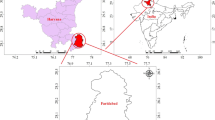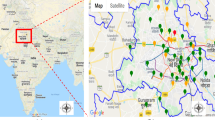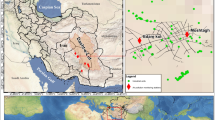Abstract
Over the years, many organizations across the globe have conducted various studies pertaining to air pollution and its ill effects. The results of these studies substantially conclude that a plethora of people succumbs to the adversities caused by the ever-increasing air pollutants. In this investigation, M5P, random forest (RF)- and Gaussian process (GP)-based approaches are used to predict the tropospheric ozone for Amritsar, Punjab state of India, metropolitan area. The models proposed were based on ten input parameters viz. particulate matter PM2.5, particulate matter PM10, sulphur dioxide (SO2), nitrogen dioxide (NO2), nitric oxide (NO), ammonia (NH3), temperature (T), solar radiation (SR), wind direction (WD) and wind speed (WS), while the tropospheric ozone (O3) was an output parameter. Three most popular statistical parameters such as correlation coefficient (CC), mean absolute error (MAE) and root mean square error (RMSE) were used for the assessment of the developed models. In comparison, it was found that better results were achieved with random forest-based model with CC value as 0.8850, MAE value as 0.0593 and RMSE value as 0.0772 for testing stage. The suggested models are expected to save cost of instrument, cost of labour work, time and contribute to greater accuracy. A result of sensitivity investigation concludes that the solar radiation is the most influencing parameter in estimating the actual values of O3 based on the current data set.






Similar content being viewed by others
Explore related subjects
Discover the latest articles and news from researchers in related subjects, suggested using machine learning.References
Basagana X, Rivera M, Aguilera I, Agis D, Bouso L, Elosua R, Foraster M, de Nazelle A, Nieuwenhuijsen M, Vila J, Kunzli N (2012) Effect of the number of measurement sites on land use regression models in estimating local air pollution. Atmos Environ 54(1):634–642. https://doi.org/10.1016/j.atmosenv.2012.01.064
Breiman L (1999). Random forests. UC Berkeley TR567
Breiman L (2001) Random Forests. Mach Learn 45(1):5–32. https://doi.org/10.1023/a:1010933404324
Breiman L, Friedman J, Stone CJ, Olshen RA (1984) Classification and regression trees. CRC Press
Dirks K, Scarfe J, Talbot NP, Marshall R, Salmond J (2017) A statistical analysis of the relationship between Brown Haze and surface air pollution levels on respiratory hospital admissions in Auckland, New Zealand. Climate 5(4):86. org/https://doi.org/10.3390/cli5040086
Gauld R, Blank R, Burgers J, Cohen AB, Dobrow MK, Ikegami NKI, Kwon S, Luxford K, Milett C, Wendt C (2008) The world health report 2008—primary healthcare: How wide is the gap between its agenda and implementation in 12 high-income health systems? Health Policy. 2013.22778. https://doi.org/10.12927/hcpol
Haghiabi AH, Nasrolahi AH, Parsaie A (2018) Water quality prediction using machine learning methods. Water Qual Res J 53(1):3–13. https://doi.org/10.2166/wqrj.2018.025
Heddam S (2014) Modelling hourly dissolved oxygen concentration (DO) using dynamic evolving neural-fuzzy inference system (DENFIS)-based approach: case study of Klamath River at Miller Island Boat Ramp, OR, USA. Environ Sci Pollut Res 21(15):9212–9227. https://doi.org/10.1007/s11356-014-2842-7
Jiménez AM, Torrecilla RC, Dominguez MJ, Garcia AP, Suarez PM (2016) Assessing environmental justice through potential exposure to air pollution: a socio-spatial analysis in Madrid and Barcelona, Spain. Geoforum 69(1):117–131. org/https://doi.org/10.1016/j.geoforum.2015.12.008
Kang F, Han S, Salgado R, Li J (2015) System probabilistic stability analysis of soil slopes using Gaussian process regression with Latin hypercube sampling. Comput Geotech 63:13–25. https://doi.org/10.1016/j.compgeo.2014.08.010
Kisi O, Sanikhani H, Cobaner M (2017) Soil temperature modeling at different depths using neuro-fuzzy, neural network, and genetic programming techniques. Theoret Appl Climatol 129(3–4):833–848. https://doi.org/10.1007/s00704-016-1810-1
Kwin CT, Talei A, Alaghmand S, Chua LH (2016) Rainfall-runoff modeling using dynamic evolving neural fuzzy inference system with online learning. Procedia Eng 154:1103–1109. https://doi.org/10.1016/j.proeng.2016.07.518
Liu ZZ, Wang JY, Wang HT (2017) Ozone measurements at some work places for environment protection and career health care. Ozone Sci Eng. https://doi.org/10.1080/01919512.2017.1304201
Mehdipour V, Memarianfard M (2019) Ground-level O 3 sensitivity analysis using support vector machine with radial basis function. Int J Environ Sci Technol 16(6):2745–2754. https://doi.org/10.1007/s13762-018-1770-3
Mehdipour V, Stevenson DS, Memarianfard M, Sihag P (2018) Comparing different methods for statistical modeling of particulate matter in Tehran. Iran Air Quality, Atmosphere & Health 11(10):1155–1165. https://doi.org/10.1007/s11869-018-0615-z
Mohanty S, Roy N, Singh SP, Sihag P (2019) Estimating the strength of stabilized dispersive soil with cement clinker and fly ash. Geotech Geol Eng 37(4):2915–2926. https://doi.org/10.1007/s10706-019-00808-1
Monks PS, Archibald AT, Colette A, Cooper O, Coyle M, Derwent R, Fowler D, Granier C, Law KS, Mills GE, Stevenson DS, Tarasova O, Thouret V, Schneidemesser von E, Sommariva R, Wild O, Williams ML (2015) Tropospheric ozone and its precursors from the urban to the global scale from air quality to short-lived climate forcer. Atmos Chem Phys 15(15):8889–8973. https://doi.org/10.5194/acp-15-8889-2015
Quinlan J R (1992). Learning with continuous classes. In 5th Australian joint conference on artificial intelligence (Vol. 92, pp. 343–348). https://doi.org/10.1142/9789814536271
Schlink U, Dorling S, Pelikan E, Nunnari G, Cawley G, Junninen H, Greig A, Foxall R, Eben K, Chatterton T, Vondracek J, Richter M, Dostal M, Bertucco L, Kolehmainen M, Doyle M (2003) A rigorous inter-comparison of ground-level ozone predictions. Atmos Environ 37(23):3237–3253. https://doi.org/10.1016/S1352-2310(03)00330-3
Schlink U, Herbarth O, Richter M, Dorling S, Nunnari G, Cawley G, Pelikan E (2006) Statistical models to assess the health effects and to forecast ground-level ozone. Environ Model Softw 21(4):547–558. https://doi.org/10.1016/j.envsoft.2004.12.002
Seeger M (2004) Gaussian processes for machine learning. Int J Neural Syst 14(02):69–106. https://doi.org/10.1142/S0129065704001899
Sepahvand A, Singh B, Sihag P, NazariSamani A, Ahmadi H, Fiz Nia S (2019) Assessment of the various soft computing techniques to predict sodium absorption ratio (SAR). ISH J Hydraul Eng. https://doi.org/10.1080/09715010.2019.1595185
Shi JQ, Choi T (2011) Gaussian process regression analysis for functional data. CRC Press
Sihag P, Esmaeilbeiki F, Singh B, Pandhiani SM (2019a) Model-based soil temperature estimation using climatic parameters: the case of Azerbaijan Province. Iran Geol, Ecol, and Landsc. https://doi.org/10.1080/24749508.2019.1610841
Sihag P, Esmaeilbeiki F, Singh B, Ebtehaj I, Bonakdari H (2019b) Modeling unsaturated hydraulic conductivity by hybrid soft computing techniques. Soft Comput 23(23):12897–12910. https://doi.org/10.1007/s00500-019-03847-1
Sihag P, Kumar V, Afghan FR, Pandhiani, SM, Keshavarzi A (2019c). Predictive modeling of PM 2.5 using soft computing techniques: case study—Faridabad, Haryana, India. Air Quality, Atmosphere & Health. 12(12), 1511–1520. https://doi.org/10.1007/s11869-019-00755-z
Singh B, Sihag P, Singh K (2017) Modelling of impact of water quality on infiltration rate of soil by random forest regression. Model Earth Syst Environm 3(3):999–1004. https://doi.org/10.1007/s40808-017-0347-3
Singh B, Sihag P, Pandhiani SM, Debnath S, Gautam S (2019) Estimation of permeability of soil using easy measured soil parameters: assessing the artificial intelligence-based models. ISH J Hydraul Eng. https://doi.org/10.1080/09715010.2019.1574615
Solomatine DP, Xue Y (2004) M5 model trees and neural networks: application to flood forecasting in the upper reach of the Huai River in China. J Hydrol Eng 9(6):491–501. https://doi.org/10.1061/(ASCE)1084-0699(2004)9:6(491)
Williams, C. K., & Rasmussen, C. E. (2006). Gaussian processes for machine learning (Vol. 2, No. 3, p. 4). Cambridge, MA: MIT press.
Zaji AH, Bonakdari H, Gharabaghi B (2018) Reservoir water level forecasting using group method of data handling. Acta Geophys 66(4):717–730. https://doi.org/10.1007/s11600-018-0168-4
Acknowledgements
We are thankful for Central Pollution Control Board, India for providing the data which are used in this study.
Author information
Authors and Affiliations
Corresponding author
Ethics declarations
Conflict of interest
There is no conflict of interest among authors.
Additional information
Editorial responsibility: Samareh Mirkia.
Rights and permissions
About this article
Cite this article
Sihag, P., Pandhiani, S., Sangwan, V. et al. Estimation of ground-level O3 using soft computing techniques: case study of Amritsar, Punjab State, India. Int. J. Environ. Sci. Technol. 19, 5563–5570 (2022). https://doi.org/10.1007/s13762-021-03514-9
Received:
Revised:
Accepted:
Published:
Issue Date:
DOI: https://doi.org/10.1007/s13762-021-03514-9




